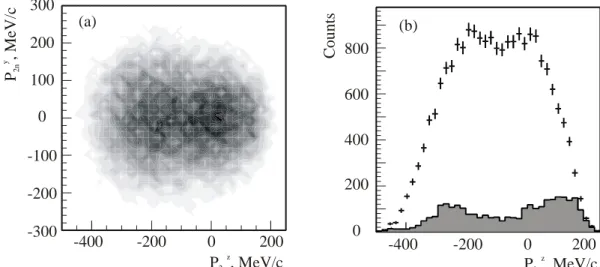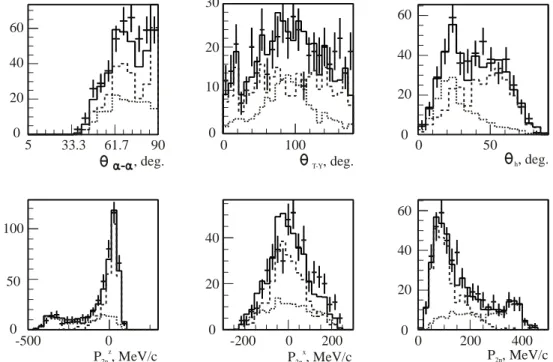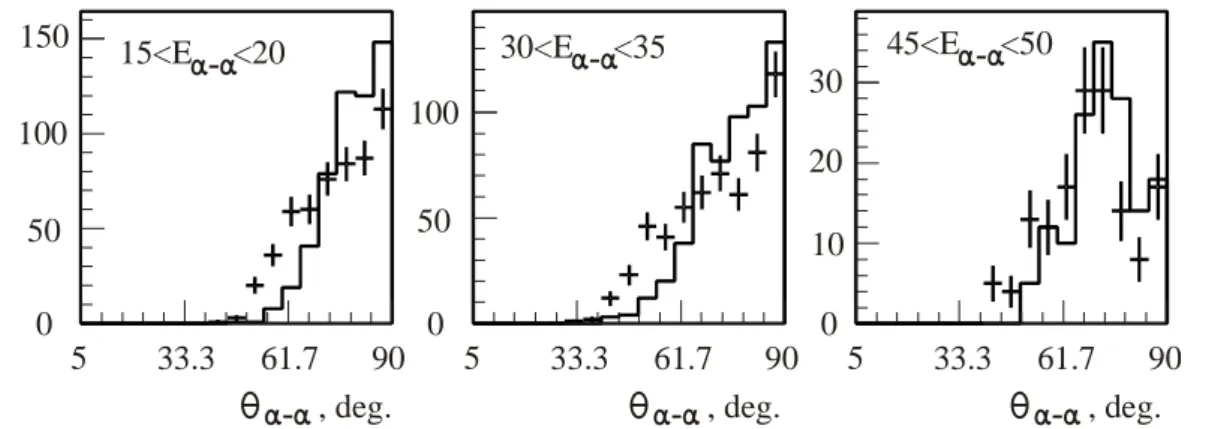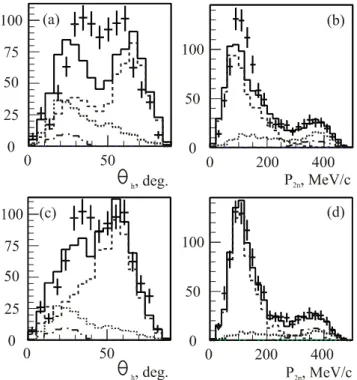HAL Id: in2p3-00125237
http://hal.in2p3.fr/in2p3-00125237
Submitted on 18 Jan 2007HAL is a multi-disciplinary open access archive for the deposit and dissemination of sci-entific research documents, whether they are pub-lished or not. The documents may come from teaching and research institutions in France or abroad, or from public or private research centers.
L’archive ouverte pluridisciplinaire HAL, est destinée au dépôt et à la diffusion de documents scientifiques de niveau recherche, publiés ou non, émanant des établissements d’enseignement et de recherche français ou étrangers, des laboratoires publics ou privés.
Experimental studies of 3-body correlations in
6He in
the quasi-free knockout reaction
4He(
6He,2α)2n
S.I. Sidorchuk, A.S. Fomichev, M.S. Golovkov, V.L. Grigorenko, V.A.
Gorshkov, A.V. Gorshkov, S.A. Krupko, Yu.Ts. Oganessian, A.M. Rodin, R.S.
Slepnev, et al.
To cite this version:
S.I. Sidorchuk, A.S. Fomichev, M.S. Golovkov, V.L. Grigorenko, V.A. Gorshkov, et al.. Experimental studies of 3-body correlations in 6He in the quasi-free knockout reaction 4He(6He,2α)2n. The 11th International Conference on Nuclear Reaction Mechanisms, Jun 2006, Varenna, Italy. pp.459-465. �in2p3-00125237�
Experimental Study of 3-body correlations in
6He in the Quasi-Free Knockout
Reaction
4He(
6He,2α)2n
S.I. Sidorchuk1,A.S. Fomichev1,
M.S.
Golovkov1, V.L. Grigorenko1, V.A. Gorshkov1, A.V. Gorshkov1, S.A. Krupko1, Yu.Ts. Oganessian1, A.M. Rodin1, R.S. Slepnev1, S.V. Stepantsov1,G.M. Ter-Akopian1, R. Wolski2, A.A. Korsheninnikov3, E.Yu. Nikolskii3, P. Roussel-Chomaz4, W. Mittig4, E.A. Kuzmin5, B.G. Novatski5, D.N. Stepanov5
1
Flerov Laboratory of Nuclear Reactions, JINR, 141980 Dubna, Russia
2
The Henryk Niewodniczanski Institute of Nuclear Physics, Krakow, Poland 3
RIKEN, Hirosawa 2-1, Wako, Saitama 351-0198, Japan
4
GANIL, BP 5027, F-14076 Caen Cedex 5, France
5
The Kurchatov Institute, Kurchatov sq. 1, 123182 Moscow, Russia
Introduction
Quasi-free scattering (QFS) of nucleon and clusters bound in nuclei is acknowledged as a powerful tool for the nuclear structure study [1-3]. Momentum distributions for the knocked-out nucleons and clusters have been extracted from the data of experiments where the remaining third body (spectator) was either nuclear stable or was found in a quasi-stationary state. In many papers the experimental data were analyzed using the Plane Wave Impulse Approximations (PWIA). It was shown by these studies that better correspondence between experimental data and theory predictions can be achieved at higher collision energies. The extension of the PWIA is the Distorted Wave Impulse Approximation (DWIA), in which one takes into account the distortions of the incoming and outgoing waves by using suitable optical model potentials [4]. Even at relatively low beam energy, the use of DWIA allowed the authors to come to more reasonable values of spectroscopic factors and make consistent theoretical predictions for the measured momentum distributions. Results obtained for the QFS reaction 6Li(α,2α)d, studied at the 4He beam energy close to 100 MeV, showed that both the PWIA and DWIA calculations provide rather close descriptions of the experimental data obtained for the 6Li nucleus [5]. Apparently, this could be the case due to the small separation energy known for α cluster in 6Li. This allows one to assume that perhaps QFS data analyzed within the framework of PWIA can be informative for the study of the cluster structures of halo nuclei near the drip-line. In particular one could expect that the reaction of QFS can be used for the direct observation of three-body correlations specific for the ground state of Borromean nuclei.
Helium-6 nucleus is a convenient object to check this assumption as one can believe that the three-body wave function (WF) is well established in theory for this nucleus [6]. However, the peculiarity of 6He consists in the lack of a bound state for the two neutrons becoming free at the knock out of α core. Similar situation occurred when the QFS reactions 6Li(α,2α)pn and 6
Li(p,pα)pn were investigated [7,8] for gaining knowledge about the three-body state of 6Li. These experiments were performed in coplanar geometry with the use of so called “point” detectors.
In our experiment we studied the reaction 4He(6He,2α)2n at a 6He beam energy of 25A MeV with emphasis made on the observation of the QFS of 4He target nuclei on α cores bound in the 6He projectile nuclei. We detected two scattered α-particles in a kinematical range corresponding to the QFS whereas two unobserved neutrons were expected to be spectators. For the first time the reaction of QFS was studied in such wide angular range of outgoing α-particles.
Experimental details
The experiment was performed in Dubna at the fragment separator ACCULINNA [9]. The secondary beam of 6He nuclei of the intensity of about 2·104 s-1 bombarded helium target cooled down to a temperature of about 16 K. The thickness of the target made 2·1020 cm-2. Standard time-of-flight technique was applied for identification of incoming particles and
measuring their energy. Two multiwire proportional chambers were used for tracking individual beam ions. Two α particles outgoing from the target in angular ranges of ±(15°-55°) were detected in coincidence by means of two identical ∆E-E telescopes. The telescopes installed symmetrically in respect to the beam direction provided for the measurement of X&Y coordinates and the energy of the reaction products. Each telescope consisted of two Si strip detectors (70 µ, 50x50 mm2 and 1000µ, 61x61 mm2), used for the measurement of energy loss
∆E, and a 6.2 mm thick Si(Li) detector (66x66 mm2). The measured energies and angles of the two coincident α-particles allowed calculating the value of the relative momentum of two unobserved neutrons and the momentum vector of their center-of-mass. The background was measured in the run done with the empty target.
Data analysis
For the reaction 4He(6He,2α)2n with four particles in the exit channel one can foresee various reaction channels (e.g. inelastic scattering resulting in 6He excitation and breakup, 1n and 2n transfers, etc.) contributing in the kinematics region where the QFS is detected. In Fig. 1(a) the distribution of momentum value p2n of the center-of-mass (CM) of the two neutrons is shown for the detected events. The p2nmomentum is calculated in the anti-lab system, i.e. in the frame moving with the velocity of incoming 6He, p2zn is the longitudinal component of this momentum along the 6He beam direction and p2yn is one of its transversal components. Two loci are clearly seen in Fig. 1(a). The first one is located in the QFS region, i.e. close to the zero momentump2zn, whereas the second is distributed in the vicinity of p2zn ≈–200 MeV/c. This point approximately corresponds to the CM momentum of the total system α+α+n+n.
P , M eV /c 2 n y 800 600 400 200 0 -400 -200 0 200 P , MeV/c2n z C o u n ts -400 -200 0 200 P , MeV/c2n z -300 -200 -100 100 0 200 300 (a) (b)
Figure 1.a) the momentum distribution of the two neutron CM p2n obtained for the detected events (see explanations in the text); b) the distribution of longitudinal component of p2n
r
obtained for all detected events (points with error bars) and for events selected at a condition En-n<5 MeV (grey histogram).
In the projection of this distribution onto p2zn axis made for all detected events (shown in Fig. 1(b) by points with error bars) the two loci heavily overlap. The distribution shown by the grey histogram in the Fig.1(b) is obtained for events with small n-n relative energy En-n<5 MeV. Two more or less separated peaks are seen in this distribution. The left peak centered at negative p2zn originates from the 2n-transfer reaction from 6He to 4He with the formation of the first Jπ=2+ resonance state of 6He. The right pick corresponding to the 2n system with small p2n values can be assigned to QFS.
For the data analysis we performed complete Monte-Carlo (MC) simulation of the reaction studied. In this simulation we used a standard PWIA formalism based on the following T matrix factorization: n n n n n PS free n n n QFS d d dE dE F d d p p S d d − − − − − − − ∝ Ω Ω Ω Ω 2 2 2 2 ) , ( α α α α α α α
σ
σ
r r , (1)whereFPS = En−nEα−α(E0 +Q−En−n −Eα−α) is the phase space factor taking into account the energy conservation law, E0=En-n+Eα-α+E2α-2n-Q – the total CM energy of the α+α+n+n system,
) , (pn n p2n
S r − r is the spectral function which represents the probability density for the 2n system to be found in a final state characterized with momentum vectors prn−n and pr2n. The subscript 2α-2n relates to the motion of the CM of α-α pair in respect to the CM of the two neutrons. The cross section of α-α elastic scattering was calculated for the relative energy Eα-α between two detected α-particles, i.e. the use was made of the post collision prescription.
Due to the large acceptance provided by the detection system the two α particles were observed in wide ranges of their relative energy Eα-α (5 – 60 MeV) and CM scattering angle θα-α (30o – 150o). The dependence of the cross-section on Eα-α and θα-α was derived from the known set of phase shifts measured in a proper energy range [10,11,12]. The 2D-matrix dσ/dΩα-α = F(Eα-α,θα-α) used in the simulation is shown in the Fig. 2(a). The angle θα-α was defined as follows:
(
)
prior post prior post p p p p α α α α α α α α α αθ
− − − − − = r r r r cos , (2) where(
)
− + = − − α α α α αµ
m p V p n He prior 2 6 r r ris the relative momentum between the α particles in the prior collision prescription, prαpost−α is that momentum in the post collision prescription, V6He
r
is the lab velocity of 6He and
µ
α−α is the reduced mass.Spectral function containing structure information was calculated taking into account the n-n final state interaction:
) , ( ) , ( ) , ( 6 2 * 2 2 2 2 n n n He r p i n n n n n n n n n n n n p dr dr p r e r r p S r r r r r r n n r r r r − − − − − − − =
∫
ψ ψ , (3)where ψ6He(rrn−n,rr2n)is a three-body WF of 6He [8]. Momentum correlations obtained for the spectral function are presented in Fig. 2(b). For comparison in Fig. 2(c) the WF of 6He in the momentum representation is shown. Two intensively populated loci correspond to the di-neutron
0 100 200 300 0 40 80 120 160 200 P , MeV/c2n P , M eV /c n -n 80 60 40 10 20 30 40 50 60 70 , deg. E , M eV (a) (b) 0 40 80 120 160 200 P , M eV /c n -n 0 100 200 300 P , MeV/c2n (c)
Figure 2. a) dσ/dΩα-α(Eα-α,θα-α) matrix, used in the MC simulation;
b) probability of finding two neutrons in states with momentum values pn−n and p2n, obtained from the spectral function (3); c) WF of 6He in the momentum representation.
component of the WF (large pn−n, small p2n) and the cigar-like one (large p2n, small pn−n). The dip between the components arises from the so called Pauli focusing.
Incomplete kinematics conditions were inherent to the present measurements. As a result, only one exit channel, the 6He+4He→6He2++α reaction intervening in the observation of the QFS could be reliably identified. However, though one could not neglect other reaction channels which also contribute in the pattern seen in Fig. 1(a) we will show that this contribution was considerably suppressed by the event selection made with the choice of large α-2n relative energy: Eα1-2n>10 MeV and Eα2-2n>10 MeV. At this choice, the contribution of reaction channels resulting in the population of high-lying continuum excited states in 6He was well described by phase space (PS) of the four-body break-up 6He+4He→α+α+n+n. This selection was used in the
presentation made below.
In order to enhance the reliability of data explanation, a set of experimental distributions was simultaneously fitted with the use of MC simulation. This set includes the distributions over eight essentially independent observables relating to the reaction mechanism and the structure of 6
He. These are: the total momentum of the 2n CM system p2n and the two projections z
n p2 and x
n
p2 , the relative energies Eα-α and En-n, the θα-α angle, the Treiman-Yang angle θT-Y [13], and the hyper angle θh characterizing in Jacoby coordinates the three-body correlations occurring in 6He:
α
θ
h = En−n E n− tg / ~2 , where α α µ − − = n n n p E 2 2 2 2 2 ~ . ResultsFits were made in the whole ranges of the Eα-α and En-n variables. Fig. 3 shows the fit results obtained in the energy ranges 35<Eα-α<40 MeV and En-n<10 MeV. The results of the MC simulations made for the QFS and the four-body PS are shown by dashed and dotted histograms, respectively. The solid histogram is the sum of the QFS and the PS contributions, the points with
60 40 20 0 5 33.3 61.7 90 , deg. 30 20 10 0 0 100 T-Y, deg. 60 40 20 0 0 50 h, deg. 60 40 20 0 0 200 400 P , MeV/c2n 40 20 0 -200 0 200 P , MeV/c2n x 100 50 0 -500 0 P , MeV/c2n z
Figure 3.The results of a fit to experimental data obtained in the energy ranges 35< Eα-α<40 MeV and En-n<10 MeV. The QFS contribution is shown by dashed histogram,
dotted histogram corresponds to the 4-body PS. Solid histogram is the sum of the QFS and PS contributions, points with error bars show the experimental data.
error bars are the experimental data. One sees that the distributions given by the model are in excellent agreement with the experimental data.
A good agreement was also obtained in the fits performed in other ranges of Eα-α and En-n. The ratio of the experimental cross-section dσ/dΩα-α extracted from the data with the use of the eq. (1) to that of the free α-α elastic scattering was found to be constant within a factor of 30% in the
whole energy range 10<Eα-α<50 MeV and 0<En-n<40 MeV.
A good test for the applicability of Eq. (1) makes the comparison of the angular dependence calculated for the free α-α elastic scattering cross section with the dependence measured in the experiment. In Fig. 4 shown are angular distributions obtained in various Eα-α
ranges with a condition of En-n<10 MeV imposed. Angular distribution characterizing the QFS is sensitive to the Eα-α value and has specific shapes, strongly varying within the Eα-α energy range
measured in the experiment. At the same time, the α-α elastic scattering cross sections vary by more than 2 orders of magnitude within the energy and angular ranges covered by the acceptance of the detection system used in these measurements. It is seen in Fig. 4 that the MC simulation well reproduces the essential features of the experimental distributions.
100 50 0 30 20 10 0 5 33.3 61.7 90 5 33.3 61.7 90 100 50 0 5 33.3 61.7 90
, deg. , deg. , deg.
15<E <20 30<E <35 45<E <50
Figure 4. The angular dependences of the cross-section of the QFS measured
at different energies Eα-α for the n-n relative energy En-n<10. The QFS contribution
is shown by the dashed histogram, the dotted one corresponds to the 4-body PS. The solid histogram is the sum of the QFS and the PS contributions, the points with error bars
are the experimental data.
In order to check if the angular distributions presented in Fig. 4 are sensitive to the choice of axis from which the θα-α angle is reckoned, we compare in Fig. 5 the experimental θα-α distributions presented in Fig. 4 (points with error bars) with similar distributions emerging from
100 100 150 50 0 5 33.3 61.7 90 15<E <20 , deg. 5 33.3 61.7 90 50 0 30<E <35 , deg. 5 33.3 61.7 90 30 20 10 0 45<E <50 , deg.
Figure 5. Experimental angular dependence of the QFS cross section obtained for different Eα-α bins at fixed n-n relative energy En-n<10. Points with error bars show the experimental distribution obtained by
taking angle θα-α defined in Eq. (2). The case with angle θα-α calculated from Eq. (4) is shown by solid histogram.
MC simulation made with angle θα-α defined in respect to the direction of the momentum vector of 6He p6He
r
taken in lab system:
(
)
He post He post p p p p 6 6 cos r r r r α α α α α α θ − − − = . (4)The latter distributions are shown in Fig. 5 by solid histograms. At large α-α relative energy 45<Eα-α<50 MeV the angles θα-α defined according to eqs. (2) and (4) are very close one to
another and the two angular distributions practically coincide. At lower Eα-α the dependences of
the cross-section on the angle reckoned from the direction of the momentum pr6He have no any noticeable features in comparison with those on the angle defined in respect to the direction of the momentum prαprior−α . One should note that at E0~60 MeV the vector
prior
prα−α strongly depends on the internal motion of α-particle bound in 6He and varies for each individual event whereas the vector p6He
r
is fixed. More pronounced structure of the distribution for the angle θα-α can be considered as the evidence in favor of the assumption that just the vector of the momentum
prior pα−α
r
defines a real direction of the collision in the input reaction channel.
In Fig. 6 we present the results of fits to the experimental distributions in momentum p2n and hyper angle θh obtained at a condition of the full En-n range and 30<Eα-α<35 MeV. The fits
were made with the use of two different MC simulations. In Figs. 6(c) and (d) dashed histograms show the contribution of the QFS obtained with the use of spectral function (3); dotted histograms correspond to the four-body PS. The assumed contribution of the T=2 excited state of 8
Be, which could be populated in the 2p transfer from 4He to 6He, is shown by the dash-dotted histogram. The fit presented in Figs. 6 (a) and (b) was made with the use of Eq. (1) and spectral function replaced by the WF of 6He in the momentum representation (see Fig. 2(c)). One sees that this fit is considerably less consistent with the experimental data. Particularly, the dip between the di-neutron and cigar-like components visible in the simulated θh distribution was not observed in the experiment.
Figure 6. The hyper angle θh and momentum p2n distributions obtained in energy range 30< Eα-α<35 MeV. The QFS contribution presented by dashed histograms was obtained with the use of spectral
Summary
In our experiment the QFS of the α core bound in 6He was explored keeping in mind the possible study of the structure of this neutron drip nucleus. Possible use of QFS for revealing momentum correlations specific for three-body Borromean nuclei was the subject of our interest. The three-body WF of 6He is believed to be well established in theory and a comparison of theoretical predictions with experimental data could be a good test for the convenience of QFS for the study of cluster states of halo nuclei.
For the first time coincident α particles arising in the 4He(6He,2α)nn reaction were detected in a wide angular range providing for a wide kinematical range of the measured angular and momentum distributions. The contribution of reactions competing with QFS in the α+α+n+n output channel was considerably suppressed by the selection of events with large α-2n relative energy Eα-2n>10 MeV. This condition provided for the reliable separation of events corresponding to the QFS reaction. The experimental distributions of a number of observables relevant to the reaction mechanism and the structure of 6He were compared with the results of the MC simulation based on the PWIA formalism. It was established that PWIA predictions are well consistent with experimental data when the n-n FSI is taken into account. Due to the n-n FSI such a pronounced peculiarity of the 6He WF as Pauli focusing is not observed.
The ratio of the experimental cross-section dσ/dΩα-α to that of the free α-α elastic scattering was found to be constant in energy ranges 10<Eα-α<50 MeV and 0<En-n<40 MeV. The angular distributions of quasifree α-α scattering measured for different energies Eα-α are well
reproduced by the MC simulation while the relative value of the α-α elastic scattering cross-section varied by more than 2 orders of magnitude within the energy and angular ranges corresponding to the acceptance of the detection system.
Acknowledgement
This work was partly supported by the Russian Foundation for Basic Research Grant No. 05-02-16404 and by the INTAS Grant No. 03-51-4496.
References
1. P.G. Roos, N.S. Chant, A.A. Cowley et al., Phys. Rev. C15 (1977) 69.
2. C.W. Wang, N.S. Chant, P.G. Roos et al., Phys.Rev. C21 (1980) 1705.
3. G. Jacob and Th.J. Maris, Rev. of Mod. Phys. 38 (1966) 121.
4. N.S. Chant and P.G. Roos, Phys. Rev. C15 (1977) 57.
5. A. Okihana, K. Ushiro, T. Yoshimura et al., Nucl. Phys. A614 (1997) 71.
6. M.V. Zhukov, B.V. Danilin, D.V. Fedorov et al., Phys. Rep. 231 (1993) 151.
7. R.E. Warner, A. Okihana, M. Fujiwara et al., Nucl. Phys. A503 (1989) 161.
8. R.E. Warner, E. Cheung, C.F. Perdrisat et al., Phys. Rev. C42 (1990) 2143.
9. A.M. Rodin et al., Nucl. Instr. Meth. A391 (1997) 228.
10. T.A. Tombrello and L.S. Senhouse, Phys. Rev. 129 (1963) 2252.
11. A.D. Bacher, F.G. Resmini, H.E. Conzett et al., Phys. Rev. Lett. 29 (1972) 1331.
12. P. Darriulat, G. Igo, H.G. Pugh and H.D. Holmgren, Phys. Rev. 137, (1965) 315.



